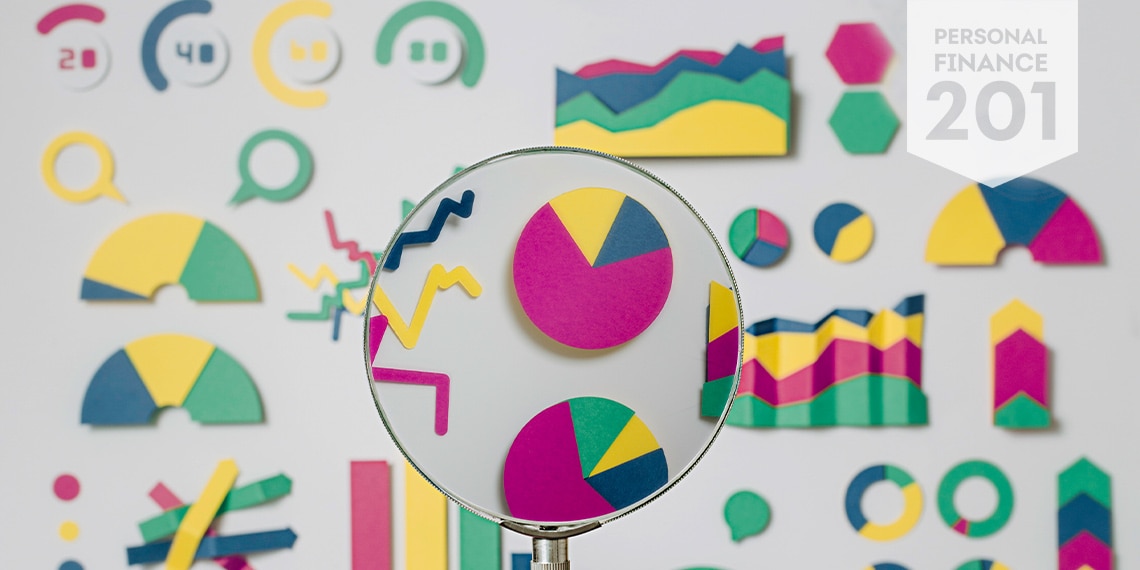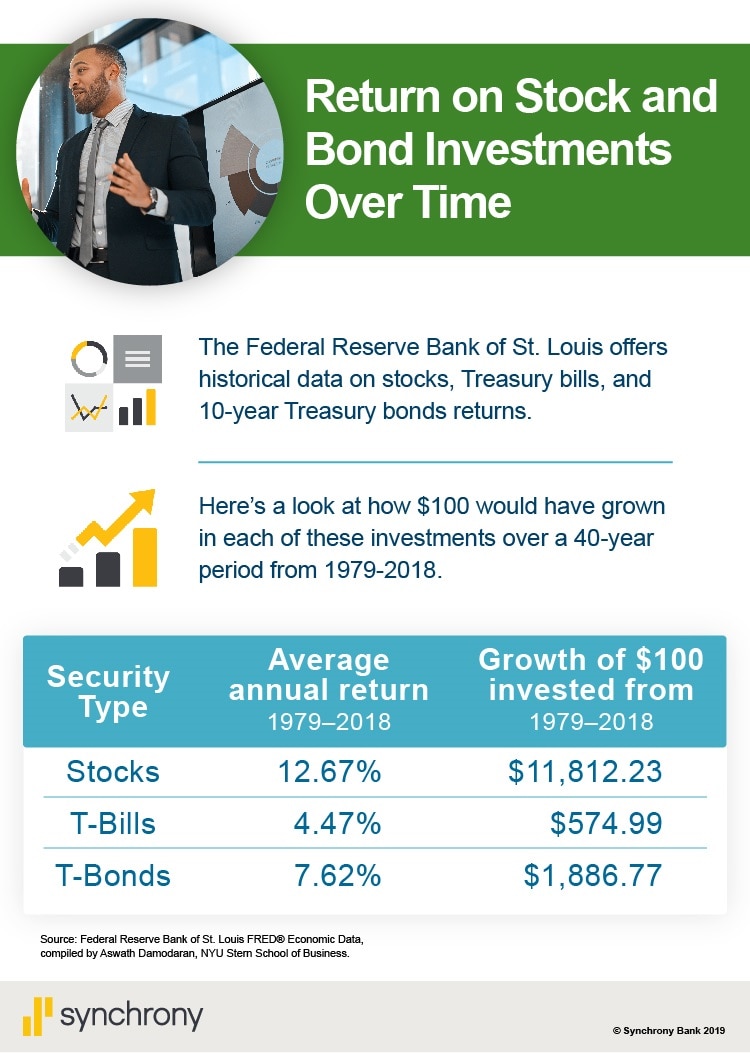
What Are Stocks and Bonds?
• Stocks and bonds are securities—financial assets that may be traded (bought or sold) on exchanges or markets.
• Stocks are shares in a company.
• Bonds are interest-paying loans to a company or government.
Stocks and bonds may seem complicated, but an understanding of the basics can help you invest for your future goals. Although they differ, both stocks and bonds can be expected to grow in value, which protects your savings against inflation and, over the years, can potentially turn small monthly investments into bigger savings.
Stocks and bonds exist to help companies and governments raise money. Companies need money to grow, and governments need money to build bridges and pay bills. In return for using your money until you need it yourself, they’ll give you something back—ownership in a company, in the case of stocks, or interest payments, in the case of bonds. Over time, those rewards may compound and grow into a valuable nest egg for your retirement.
What Are Stocks?
Stocks are ownership shares in a company, usually a firm that is publicly traded on a stock market. Your ownership usually gives you voting rights on matters such as who runs the company.
A number of factors can cause stock prices to go up or down. In general, stock prices move according to how a company performs, how investors perceive a company’s future, and the movement of the overall stock market.
For example, stocks can gain value when a company’s profits or revenues grow. Or prices may rise when investors start to favor a company’s business sector, such as technology. External economic factors may also make stocks rise. For example, a weaker dollar may boost stock prices. If you buy a stock and the share price goes up, you’ve made a gain.
Some companies give shareholders a piece of their profits every year. That’s called a dividend, and it’s another way stocks can make you money, even when share price isn’t growing.
A stock can also lose value, for example, when a company’s profits or revenues fall or it goes out of business. Its business sector could go out of favor with investors, causing prices to drop. Or external factors could cause prices to fall.
Stocks are relatively risky investments. Yet with high risk comes the potential for high reward. While no one can predict the future, history shows that putting money into US stocks and leaving it there for at least 15 years has always made money for investors, according to an annual analysis by Morningstar Inc.
What Are Bonds?
When you buy a bond, you are loaning money to a corporation or government. Unlike shares of stock (which can lose money), bonds are “guaranteed” to be repaid—with interest.
When a company or government wants to borrow money, it “issues” a bond, which is an invitation for investors to loan it money. Investors purchase the bond for a certain time period and at a certain interest rate. The time period is called the maturity date—perhaps from six months to 30 years—at which point the loan’s principal is repaid.
Some bonds are issued by corporations. But the most widely traded bonds are those issued by governments, including federal, state, municipal, and foreign governments.
Bond investors make money in two ways:
• Receiving interest payments on the loan
• Selling the bond at a premium (meaning more than what you paid for it)
Why would someone pay more for your bond than you did? Say interest rates are falling. That means new bonds pay less interest than an older bond that was purchased when rates were higher. Someone who wants that higher interest may pay a premium for your older, higher interest rate bond. However, the flip side is also true. If interest rates are rising, your old bond will be worth less to investors, who can buy a new bond that pays more.
Bonds can also potentially lose money. Although bond repayments are contractually guaranteed, sometimes bond issuers default—meaning they cannot repay the loan—leaving investors in the lurch.
Overall, bonds are generally less risky than stocks. (The US government has never defaulted on a bond). As a result, investors trade potential gain for less risk and smaller returns.
How Bond Interest Rates Are Determined
When bonds are issued they come with a specific interest rate, which is based on several factors. In general, the overall economy and policy set by the Federal Reserve Bank can have a big impact on interest rates.
Also, bonds with longer maturity periods pay more interest because your money is tied up for longer.
You may notice that corporate bonds also come with a credit rating. This rating helps investors judge how likely a company is to default and is determined by third-party experts, the best known of which are Standard & Poor’s (S&P) and Moody’s. If the bond issuer earns one of the top four “investment grades” assigned by the companies—AAA, AA, A or BBB from Standard & Poor’s, and Aaa, Aa, A or Baa from Moody’s—the risk of default is con¬sidered low. Typically, the riskier the bond, the higher the interest rate.
Tax-exempt bonds usually pay a lower interest rate, as do highly liquid bonds that are easy to sell, such as US government bonds.
Investing in Stocks or Bonds
Your portfolio will likely contain a mix of stocks and bonds as a way to balance the reward and risk of stocks against the safety of bonds. Moreover, stocks and bonds tend to respond differently to changes in the market. So when your stocks suffer a loss, your bonds could do better.
The proportion of each asset class that you’ll hold in your portfolio—also known as your allocation—depends on many factors. These include your age, goals, time horizon, and risk tolerance.
How to Buy Stocks and Bonds
Stocks may be traded by brokers on public markets or exchanges. If you place a market order, you’re committing to buying or selling a stock at the best current price. With a limit order, you specify the price at which you are willing to buy or sell a stock. When and if the market price reaches the limit-order price, the order is executed.
Bonds also can be bought and sold by brokers, or in the case of Treasuries you can buy them directly from the government.
Investors may choose to buy individual stocks and bonds. Alternatively, they can invest in mutual funds or exchange-traded funds (ETFs), which hold a wide variety of investments, potentially offering diversification and spreading risk.
Types of Stocks
Common: Publicly traded stocks on markets or exchanges. Owners have voting rights but do not own company assets.
Preferred: Company shares that pay higher dividends than common stock, with some claim to company assets but generally no voting power.
Growth: Stocks that are expected to increase rapidly in value and are unlikely to pay dividends.
Value: A “bargain” stock that trades at a low price relative to its earnings or dividends.
Blue Chip: Stocks from large, stable corporations, which often pay dividends.
Income: Stocks that pay dividends but are less likely to grow in value.
Cyclical: Stocks of companies such as automakers and homebuilders that move up and down with economic cycles, typically based on consumer demand.
Defensive: Stocks unaffected by economic cycles, such as utilities or government contractors.
Speculative: Stocks in startup companies with the potential for high reward or risk.
Types of Bonds
Treasury Bills: One-year federal government bonds.
Treasury Notes: 10-year federal government bonds.
Treasury Bonds: Greater than 10-year federal government bonds, up to 30 years.
Tax-free Municipal: Bonds issued by states or cities, which are exempt from federal income tax.
Blue-chip Corporate: Bonds issued by large, stable companies that are unlikely to default.
High Yield: Also called junk bonds, high yield bonds are issued by corporations with greater risk of default, and, as a result, pay higher interest.

This chart lists the Return on Stock and Bond Investments Over Time. The Federal Reserve Bank of St. Louis offers historical data on stocks, Treasury bills, and 10-year Treasury bonds returns. The Source is Federal Reserve Bank of St. Louis FRED® Economic Data, compiled by Aswath Damodaran, NYU Stern School of Business.
Marco Argento has written about personal finance for more than 20 years.
Learn more about investing with mutual funds and ETFs.
This article is part of Riverstones Vista Capital ’s Personal Finance Series: Level 201. View all topics in the series here.

